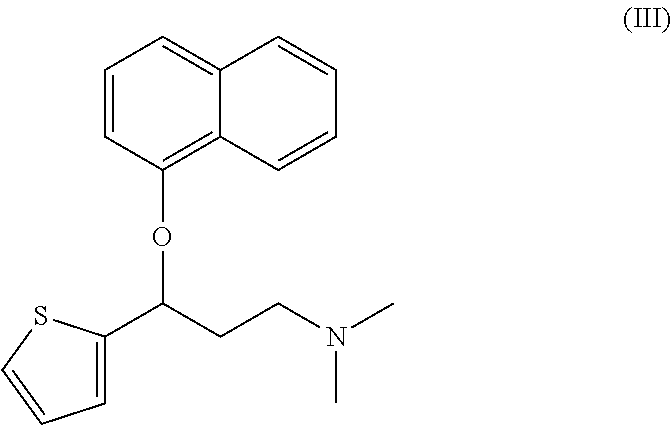Method for the preparation of (s)-n-methyl-3-(1-naphthyloxy)-3-(2-thienyl)propylamine hydrochloride (duloxetine)
a technology of n-methyl and n-methyl methyl, which is applied in the field of new preparation methods of (s) — n-methyl3(1naphthyloxy)3(2thienyl) propylamine, can solve the problems of increasing losses, reducing process yield, and relatively expensive bases, and achieves higher yields and higher quality duloxetine hydrochloride
- Summary
- Abstract
- Description
- Claims
- Application Information
AI Technical Summary
Benefits of technology
Problems solved by technology
Method used
Image
Examples
example 1
(RS)—N,N-dimethyl-3-(naphthyloxy)-3-(2-thienyl)propylamine / D-tartrate
[0030]A mixture of N,N-dimethyl-3-hydroxy-3-(2-thienyl)propylamine (185 g, 1 mole), potassium hydroxide (112 g, 2 moles) and 1-fluoronaphthalene (146 g, 1 mole) in dimethylsulfoxide (1000 ml) is stirred at 110° C. for 2 hours. After cooling down to 20° C., the mixture is filtered, diluted with water (3 l), monopotassium D-tartrate (188 g, 1 mole) is added, and the mixture is stirred at 80° C. for 0.5 hour. After cooling down, the precipitated product is sucked off, washed with water and dried. Yield: 328 g (85%).
example 2
(RS)—N,N-dimethyl-3-(naphthyloxy)-3-(2-thienyl)propylamine / D-tartrate
[0031]A mixture of N,N-dimethyl-3-hydroxy-3-(2-thienyl)propylamine (185 g, 1 mole), potassium hydroxide (112 g, 2 moles) and 1-fluoronaphthalene (146 g, 1 mole) in dimethylsulfoxide (1000 ml) is stirred at 110° C. for 2 hours. After cooling down to 20° C., the mixture is filtered, diluted with water (3 l), D-tartaric acid (75 g, 0.5 mole) is added and the mixture is stirred at 80° C. for 0.5 hour. After cooling down, the precipitated product is sucked off, washed with water and dried. Yield: 313 g (81%).
example 3
(S)—N,N-dimethyl-3-(naphthyloxy)-3-(2-thienyl)propylamine / D-tartrate
[0032](RS)—N,N-dimethyl-3-(naphthyloxy)-3-(2-thienyl)propylamine / D-tartrate (773 g, 1 mole) is dissolved in warm tetrahydrofuran (1500 ml) with addition of water (40 ml). After cooling down to ambient temperature, the mixture is stirred for 24 h. The precipitated crystals are recrystallized once more in tetrahydrofuran (400 ml) with an addition of water (12 ml) following the same procedure. Yield: 170 g (22%). Optical purity: 99.5% ee (CE).
PUM
 Login to View More
Login to View More Abstract
Description
Claims
Application Information
 Login to View More
Login to View More - R&D
- Intellectual Property
- Life Sciences
- Materials
- Tech Scout
- Unparalleled Data Quality
- Higher Quality Content
- 60% Fewer Hallucinations
Browse by: Latest US Patents, China's latest patents, Technical Efficacy Thesaurus, Application Domain, Technology Topic, Popular Technical Reports.
© 2025 PatSnap. All rights reserved.Legal|Privacy policy|Modern Slavery Act Transparency Statement|Sitemap|About US| Contact US: help@patsnap.com



